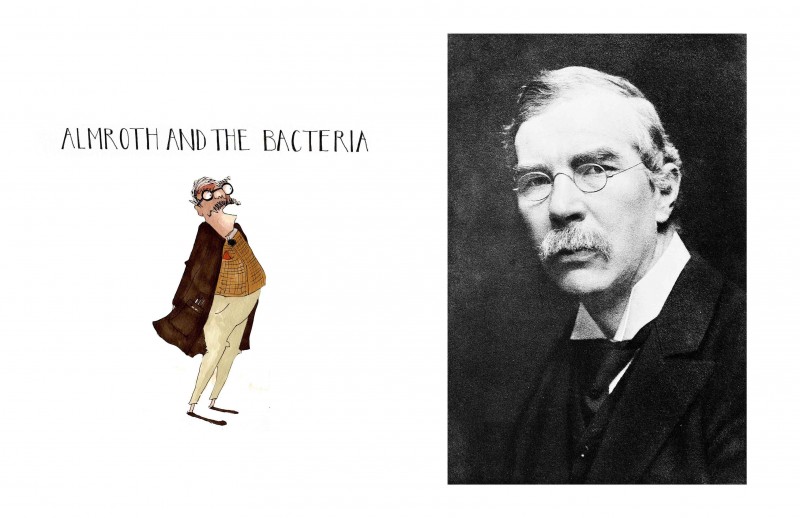By Sophie Arthur
May 15, 2018
Time to read: 4 minutes
To celebrate the pioneering scientists featured in the 2018 edition of Heroes of Health we will be writing articles about each of those featured.

Sir Almroth Wright (1861-1947), is the second in our Heroes of Health series. Almroth was one of the founding members of the MRC and is noted as the first academic immunologist in the UK.1
Having graduated from Trinity College, Dublin in 1883, Almroth held positions at the Royal College of Physicians and Surgeons, University of Cambridge and University of Sydney, and went on to be appointed Professor of Pathology in the Army Medical Services at the Royal Victoria Hospital where he stayed from 1892 to 1902.2 During this time, he noted the great suffering of men from typhoid fever, a bacterial infection that ended up killing hundreds of thousands of people during the First World War.
Whilst at the Royal Victoria Hospital Almroth devised the “Technique of the Teat and Capillary Glass Tube”3 which revolutionised the ability to test blood and bodily fluids and was able to be developed for use in testing whether patients were suffering from typhoid or other fevers.4
Alongside his work in diagnosis Almroth was incessant on finding a solution to control the symptom of fever. He worked tirelessly to develop a vaccine, trialling it on himself and surgeons on probation and finding it greatly increased the body’s ability to kill the typhoid bacteria.2,4 This was a great enhancement in the world of healthcare and has been described as “epoch-making”2 and once rolled out saved many lives.
Despite being known and celebrated as a pioneer in immunology,4 Almroth held some controversial views, publishing a book against women’s suffrage and declaring that bringing women into scientific society would cause it to become a “cock-and-hen” show.5 Although likely fitting with views held at the time, within history he has often been referred to as ‘Sir Almost Right’,1 with one reviewer suggesting his views in particular of women’s suffrage being “over-influenced by individual instances,” with “incomplete evidence” and a “very imperfect sense of proportion (accepting) the congenial as true, the uncongenial as false.”6
It is without doubt, that Almroth’s scientific legacy is immense and his work continues to influence immunologists of today having founded the Institute of Pathology and Research at St Mary’s Hospital, Imperial College London.2 Imperial hold an annual Almroth Wright Lecture series in which highly distinguished figures from the world of immunology discuss their research and share the current advances. It’s brilliant to note that this year’s lecture series sees the first all-female line up, with the third and final talk from Professor Anne Ferguson-Smith, Department of Genetics, University of Cambridge, Mammalian epigenetic inheritance – mechanisms and implications happening today, Tuesday 15 May.
When asked about Almroth, Professor Charles Bangham, Chair of Immunology, Imperial College London, quotes the first line of Almroth’s 1909 book, Studies on Immunisation: And Their Application to the Diagnosis and Treatment of Bacterial Infections, “The physician of the future will be an Immunisator.”7 Discussing his choice of quote Charles says “The reasons it is so apt and important are that Almroth Wright was one of the pioneers in immunisation and immunology, and that vaccines, which have been perhaps the greatest single success of medical science, are now showing promise in the campaign against antimicrobial resistant bacteria, as well as other infections.”8
Almroth will continue to be celebrated for his “epic work in the science of immunology”2 and he is one of our Heroes of Health for this very reason, the very first icon of immunology.
If you’re interested in reading more about our pioneering Heroes of Health, the first feature highlighted the career of Mary Barber: Hidden Hero of bacteriology.
References
1. IBMS History Committee, Health for Heroes, https://www.ibms.org/resources/documents/health-for-heroes-typhoid-vaccine/health-for-heroes-typhiod-vaccine.pdf.
2. In Memoriam. Sir Almroth Wright. (1947). Journal of the Royal Army Medical Corps, http://jramc.bmj.com/content/jramc/88/6/250.full.pdf.
3. Wright, A. and Colebrook, L. (1921). Technique of the Teat and Capillary Glass Tube….
4. Colebrook, L. (1953). Almroth Wright—pioneer in immunology, British medical journal, 2(4837), 635. https://www.ncbi.nlm.nih.gov/pmc/articles/PMC2029492/?page=1.
5. Wright, A. (1913). The unexpurgated case against woman suffrage.
6. Catty, N. (1913). The Unexpurgated Case Against Woman Suffrage, by Sir Almroth E. Wright. https://www.journals.uchicago.edu/doi/abs/10.1086/intejethi.24.3.2376614.
7. Wright, A. (1909). Studies on Immunisation: And Their Application to the Diagnosis and Treatment of Bacterial Infections.
8. Deploy vaccines to fight superbugs. Rappuoli et al. (2017). Nature 552:165-167.